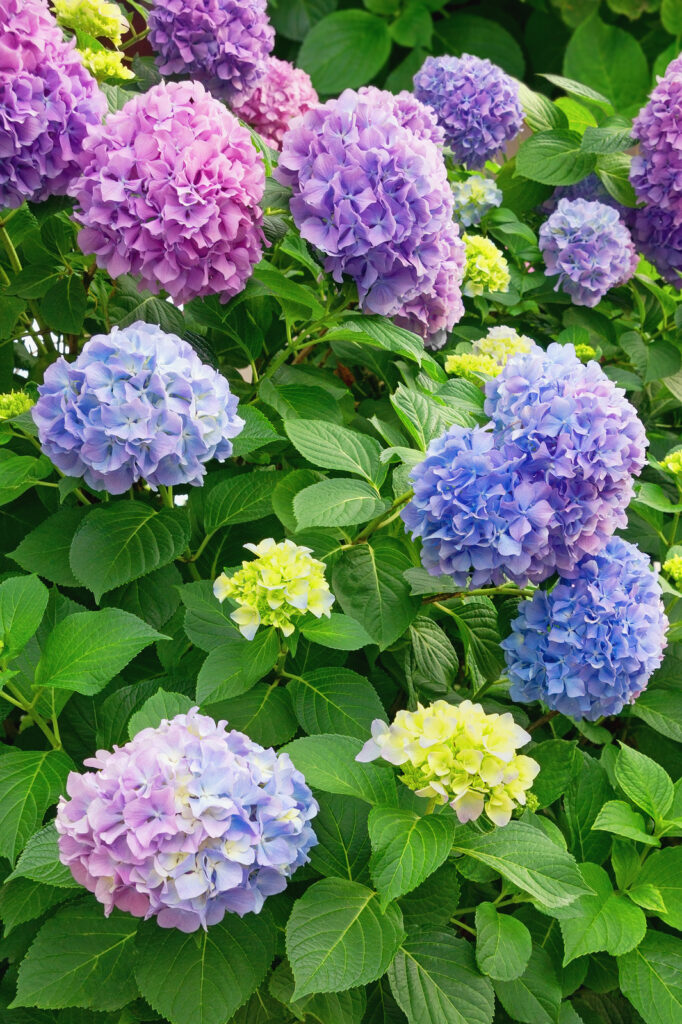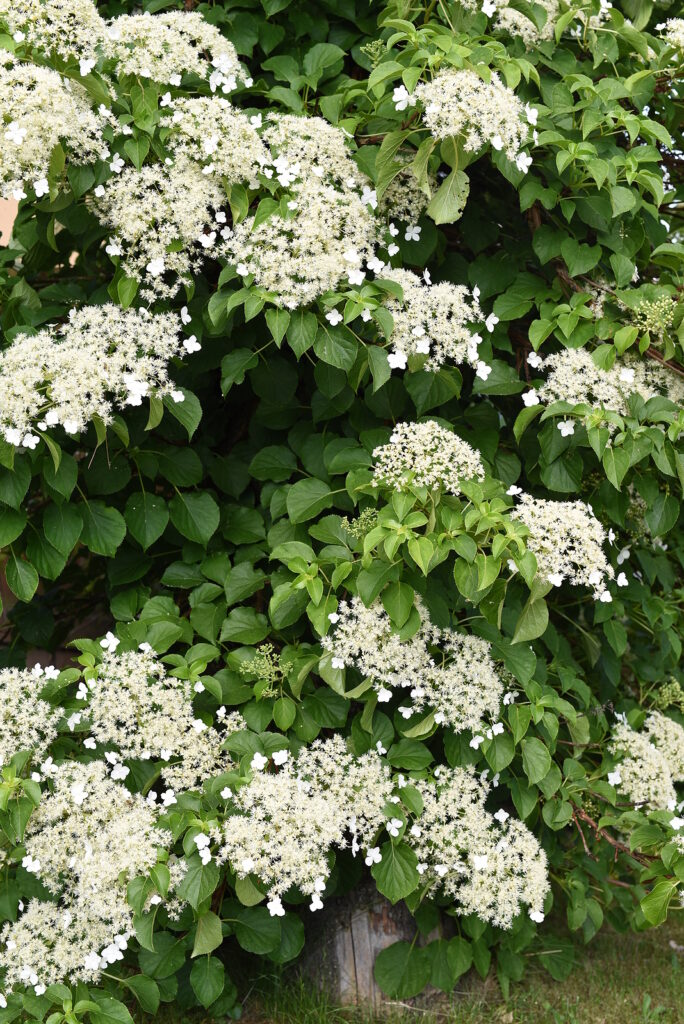Hydrangeas are grown mainly for their showy flower heads. Hydrangeas are divided into two groups: lace caps and mopheads. Lacecaps have flattened flowerheads with small flowers in the center surrounded by larger flowers around the perimeter. Mopheads have nearly spherical flower heads. Flowers of both can be white, pink, red, lavender, and blue.
Hydrangeas are deciduous shrubs native to Asia and North and South America. They belong to the Saxifrage family.
Hydrangeas thrive best in rich moist soil and flower freely in an open situation but will grow under varying conditions. Rather severe pruning should be practiced and the weak growth thinned to encourage strong shoots for good flower heads.
Garden Success Products at Amazon:
- 10 pcs Stainless Steel Garden Hand Tool Set
- Flexi Hose with 8-inch Nozzle
- Gorilla Cart 4 Cu. Ft, 300-pound Capacity
- Neem Bliss 100-% Cold Pressed Neem Oil
- Safer Brand Insect Killing Soap
- Wildflower Seed Mix Attracts Hummingbirds and Butterflies
- Eden Brothers All Perennial Seed Mix
Blue hydrangeas are very popular and sometimes a seeming miracle takes place when plants propagated from the blue variety produce pink flowers. This is due to the change in soil acidity. Blue flowers are produced in acid soil. Hence growers of pot plants often add iron to the soil or water with a solution of alum at the rate of a teaspoonful to one gallon of water, or with aluminum sulfate–3 ounces to the gallon.
Outdoors a sandy soil and the addition of peat moss, leaf mold, or any other acid-creating material will aid in keeping blue varieties blue.
Good plants can be grown in one year from cuttings. Young plants can be set outdoors in pots for summer or planted in a sunny place then lifted and potted in fall. Older plants may be cut back and planted out for another season of flowering and either protected outside or lifted and stored in a frost-proof place.

Get to know Hydrangea
- Plant type: Deciduous summer- or fall-blooming shrub
- Growing Zones and range: 4-9, more below
- Hardiness: Half-hardy
- Height and width: 6 to 15 feet (1.8-4.5m) tall, 3 to 8 feet (1-2.4m) wide depending on the variety
- Foliage: Broad to narrow ovate or lance-shaped, toothed opposite or whorled leaves
- Flowers: Two forms: (1) lacecaps have flattened flowerheads with small flowers in the center surrounded by larger flowers around the perimeter; (2) mopheads have nearly spherical flower heads. Flowers of both can be white, pink, red, lavender, and blue.
- Bloom time: Summer
- Uses: Thrives in shade; specimen plants, plantings, shrub border, or in containers; climbers can be used to clothe a shaded wall or fence or grow up tree trunks
- Garden companions: For white-flowering hydrangeas, ‘Royal-Purple’ smoke bush (Cotinus coggyria ‘Royal Purple’); Shubert chokeberry (P. virginiana ‘Shubert’)
- Common name: Hydrangea
- Botanical name: Hydrangea spp.
- Family: Hydrabgeaceae
- Origin: North and South America, East Asia
Where to plant Hydrangea
- Plant hydrangeas in full sun but protect plants from hot afternoon sun; plant in partial shade in hot summer regions
- Grow hydrangea in humus-rich, well-drained soil, preferably acidic

When to plant Hydrangea
- Set outdoors during fall or spring. Keep well-watered during summer.
Planting and spacing Hydrangea
- Space hydrangeas 3 to 8 feet apart depending on the variety,
How to water and feed Hydrangea
- Hydrangeas need ample water; keep the soil evenly moist.
- Fertilize hydrangeas with an all-purpose fertilizer in spring and again at midsummer.
Hydrangea care
- Mulch around hydrangeas with aged compost to protect the roots and feed the soil.
- Hydrangea will flower without pruning but will flower better in flowers that are cut back in fall to a strong, flat flower bud and weak. Cut old, weak stems to the ground in the fall.
- Prune Hydrangeas to control size and form.
How to Grow Hydrangea as a houseplant
- Hydrangea macrophylla can be grown as a houseplant.
- Place hydrangea in a room where the temperature is average, humidity is average to high, and light is direct.
- The medium should be soilless and kept evenly moist at all times.
Store-bought plants do not need to be fertilized. - After the flowers have faded, plants may be moved into the garden.
- If you want to force a hydrangea into bloom, the plant should be potted in the fall and placed outdoors in a dark cold frame for si week to induce flower buds before being moved indoors.
- The temperature must drop below 40°F (4.4°C) for flower buds to form.
- Tall plants may need to be staked.
- The flower color of hydrangeas can be changed by manipulating the pH; blue flowers require an acidic medium; pink flowers require an alkaline medium.
Hydrangea pests and diseases
- Hydrangeas are susceptible to attacks by slugs.
- Gray mold, powdery mildew, rust, ringspot virus, and leaf spots are also common.
Hydrangea propagation
- Sow Hydrangea seeds in containers in a cold frame in spring.
- Hydrangea macrophylla take cuttings anytime during the growing season.
- Hydrangea paniculate take cuttings in summer.
- Hydrangea quercifolia layer in spring or soil in fall.

Hydrangea varieties to grow
- H. arborescens, Wild or smooth hydrangea, rounded, deciduous shrub with long-stalked, broadly ovate leaves, to 7 inches (18cm) long, dark green above and paler beneath. Domes or flattened corymbs, to 6 inches (15cm) across, of crowded, dull-white, mainly fertile flowers are borne in summer. To 3-5 feet (1-1.7m) tall and wide. Eastern United States. Zones 5 to 9. Hydrangea arborescens blooms on the current year’s growth, so prune hard to the ground each spring; best in Zones 6-9.
- H. aspera, is an upright, deciduous shrub with large, lance-shaped to narrowly ovate, dark green leaves, to 10 inches (25cm) long, downy beneath. From late summer to autumn, bears flattened corymbs, to 10 inches (25cm) across, of blue to purple fertile flowers, surrounded by white, sometimes pink- to light purple sterile flowers. To 10 feet (3m) tall and wide. East Asia.
- H. involucrata, a spreading, deciduous shrub with broadly ovate-oblong, bristly, dark green leaves, to 6 inches (15cm) long. In late summer, bears domed corymbs, to 5 inches (13cm) across, of small, blue fertile flowers, surrounded by white to pale blue or pink sterile flowers. To 3 feet (1m) tall and 6 feet (2m) wide. Japan, Taiwan.
- H. macrophylla, bigleaf hydrangea, grows 2 to 10 feet tall in Zones 6-9; it has broad, thick leaves; it has blue or pink flowers (blue in acid soils, pink in alkaline); flowers are large, flat clusters up to 10 inches across; cultivar ‘Nikko Blue’ will bloom blue; ‘Mariesii’ bears pink flowers; all best in Zones 4-8.
- H. paniculata grows to 20 feet tall and 10 feet wide; has elliptical dark green leaves; has white flowers in large pyramidal clusters in midsummer to early fall; ‘Grandiflora’ has white, snow-ball-like flowers.
- H. petiolaris, Climbing hydrangea, vigorous, woody, deciduous climber, clinging by aerial roots. Ovate-rounded leaves, to 4.5 inches (11cm) long, have heart-shaped bases and are dark green, sometimes turning yellow in autumn. In summer, bears domed corymbs, to 10 inches (25cm) across, of white fertile and sterile flowers. To 50 feet (5m) tall. Russia (Sakhalin), Korea, Taiwan, and Japan.
- H. quercifolia grows to 10 feet tall and wide; has oak-shaped leaves; has white flowers that are borne in erect, pyramidal clusters in early to late summer; best in Zones 5-8.
- H. sargentiana, an upright, deciduous shrub with thick, bristly shoots and large, broadly ovate, very bristly, dark green leaves, to 10 inches (25cm) long. Flattened corymbs, to 9 inches (23cm) across, of blue to purple fertile flowers, surrounded by white sterile flowers, sometimes tinged purple, are produced from late summer to autumn. To 10 feet (3m) tall and more and 7-8 feet (2.2-2.5m) wide. China.
- H. serrata, Mountain hydrangea, compact, erect, deciduous shrub with narrowly ovate, pointed, mid-green leaves, to 6 inches (15cm) long. Flattened corymbs, 2-4 inches (5-10cm) across, with a few pink or blue sterile flowers and numerous blue or pink fertile flowers, open from summer to autumn. To 4 feet (1.2m) tall and wide. Korea, Japan.
- H. serratifolia, a vigorous, woody, evergreen climber, similar to H. seemanii, but with elliptic, leathery, dark green leaves, to 6 inches (15cm) long, sharply toothed on young plants. In summer, clustered, corymb-like flowerheads, to 6 inches (15cm) across, with white fertile flowers and usually no sterile flowers, open from large, spherical buds. To 50 feet (15m) tall. Chile, Argentina.
- H. villosa, spreading to erect, deciduous shrub or small tree with lance-shaped to narrowly ovate, velvety, dark green leaves, 3.5-10 inches (9-25cm) long. In late summer, bears flattened corymbs, 6 inches (15cm) across (often more), of blue-purple or rich blue fertile flowers and lilac-white or rose-lilac sterile flowers. To 4-12 feet (1-4m) tall and wide. Tibet, China, Myanmar, and Taiwan.
Hydrangea frequently asked questions
Q: How do I grow hydrangea in the house?
A: Place hydrangea in a room where the temperature is average, humidity is average to high and light is direct. Use a soilless medium and keep it evenly moist at all times. After the flowers have faded, plants may be planted in the garden.
Q: How can I force my hydrangea into blooming?
A: To force a hydrangea into bloom, pot the plants in fall and place them outdoors in a dark cold frame for six weeks to induce flower buds before you move them indoors. The temperature must drop below 40°F for flower buds to form.
Q: How long will a hydrangea flower in the house?
A: Hydrangea should flower not less than 3 weeks. Keep the plant away from a hot, sunny window and forced heat. Water thoroughly twice a day.
Q: What care should be given pot hydrangeas?
A: Florists’ hydrangeas are propagated from cuttings in early spring and grown in 4-inch pots which are sunk in the open ground during the summer. Put the plants in larger pots in autumn and place them in a protected cold frame that is well-ventilated. Bring the plant inside before hard freezing. Give the plant just enough water to prevent dying.
Q: Can my florist hydrangea be planted in the garden after it has stopped flowering?
A: Yes. After it has finished blooming cut back stems about half the length, remove the plant from the pot, and plant it in the garden where it will have plenty of room. Water well. It will grow into a big, shrubby plant.
Q: What makes the hydrangea flower blue or pink?
A: Acidity of soil causes blue flowers, but some varieties come blue more readily than others. Repeated watering with alum solution or aluminum sulfate (1 level teaspoon to 1 gallon of water) will cause blueness. Add 1 tablespoon of alum to the potting mixture to get pink flowers.
Related Articles:
- 20 Perennials That Bloom for 6 to 8 Weeks
- Shrubs with Showy Flowers Season-by-Season
- Trees in Garden Design
- Growing Annuals for Summer Bloom
- Trees—click here for more articles
- Shrubs—click here for more articles
- Perennials—click here to see more
- Annuals—click here to see more















